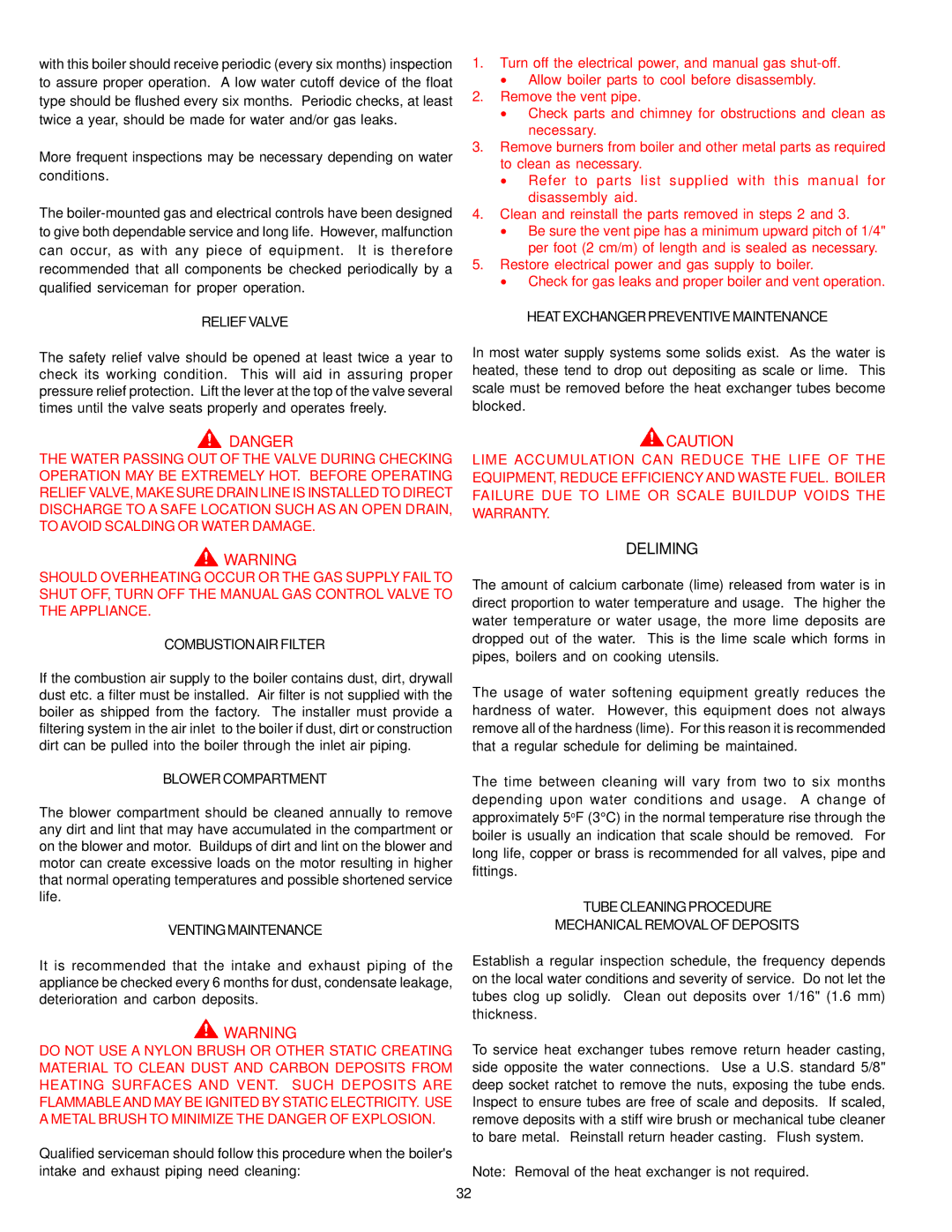with this boiler should receive periodic (every six months) inspection to assure proper operation. A low water cutoff device of the float type should be flushed every six months. Periodic checks, at least twice a year, should be made for water and/or gas leaks.
More frequent inspections may be necessary depending on water conditions.
The
RELIEF VALVE
1.Turn off the electrical power, and manual gas
•Allow boiler parts to cool before disassembly.
2.Remove the vent pipe.
•Check parts and chimney for obstructions and clean as necessary.
3.Remove burners from boiler and other metal parts as required to clean as necessary.
•Refer to parts list supplied with this manual for disassembly aid.
4.Clean and reinstall the parts removed in steps 2 and 3.
•Be sure the vent pipe has a minimum upward pitch of 1/4" per foot (2 cm/m) of length and is sealed as necessary.
5.Restore electrical power and gas supply to boiler.
•Check for gas leaks and proper boiler and vent operation.
HEAT EXCHANGER PREVENTIVE MAINTENANCE
The safety relief valve should be opened at least twice a year to check its working condition. This will aid in assuring proper pressure relief protection. Lift the lever at the top of the valve several times until the valve seats properly and operates freely.
In most water supply systems some solids exist. As the water is heated, these tend to drop out depositing as scale or lime. This scale must be removed before the heat exchanger tubes become blocked.
![]() DANGER
DANGER
THE WATER PASSING OUT OF THE VALVE DURING CHECKING OPERATION MAY BE EXTREMELY HOT. BEFORE OPERATING RELIEF VALVE, MAKE SURE DRAIN LINE IS INSTALLED TO DIRECT DISCHARGE TO A SAFE LOCATION SUCH AS AN OPEN DRAIN, TO AVOID SCALDING OR WATER DAMAGE.
![]() WARNING
WARNING
SHOULD OVERHEATING OCCUR OR THE GAS SUPPLY FAIL TO SHUT OFF, TURN OFF THE MANUAL GAS CONTROL VALVE TO THE APPLIANCE.
COMBUSTIONAIR FILTER
If the combustion air supply to the boiler contains dust, dirt, drywall dust etc. a filter must be installed. Air filter is not supplied with the boiler as shipped from the factory. The installer must provide a filtering system in the air inlet to the boiler if dust, dirt or construction dirt can be pulled into the boiler through the inlet air piping.
BLOWER COMPARTMENT
The blower compartment should be cleaned annually to remove any dirt and lint that may have accumulated in the compartment or on the blower and motor. Buildups of dirt and lint on the blower and motor can create excessive loads on the motor resulting in higher that normal operating temperatures and possible shortened service life.
VENTING MAINTENANCE
It is recommended that the intake and exhaust piping of the appliance be checked every 6 months for dust, condensate leakage, deterioration and carbon deposits.
![]() WARNING
WARNING
DO NOT USE A NYLON BRUSH OR OTHER STATIC CREATING MATERIAL TO CLEAN DUST AND CARBON DEPOSITS FROM HEATING SURFACES AND VENT. SUCH DEPOSITS ARE FLAMMABLEAND MAY BE IGNITED BY STATIC ELECTRICITY. USE A METAL BRUSH TO MINIMIZE THE DANGER OF EXPLOSION.
Qualified serviceman should follow this procedure when the boiler's intake and exhaust piping need cleaning:
![]() CAUTION
CAUTION
LIME ACCUMULATION CAN REDUCE THE LIFE OF THE EQUIPMENT, REDUCE EFFICIENCY AND WASTE FUEL. BOILER FAILURE DUE TO LIME OR SCALE BUILDUP VOIDS THE WARRANTY.
DELIMING
The amount of calcium carbonate (lime) released from water is in direct proportion to water temperature and usage. The higher the water temperature or water usage, the more lime deposits are dropped out of the water. This is the lime scale which forms in pipes, boilers and on cooking utensils.
The usage of water softening equipment greatly reduces the hardness of water. However, this equipment does not always remove all of the hardness (lime). For this reason it is recommended that a regular schedule for deliming be maintained.
The time between cleaning will vary from two to six months depending upon water conditions and usage. A change of approximately 5oF (3°C) in the normal temperature rise through the boiler is usually an indication that scale should be removed. For long life, copper or brass is recommended for all valves, pipe and fittings.
TUBE CLEANING PROCEDURE
MECHANICAL REMOVAL OF DEPOSITS
Establish a regular inspection schedule, the frequency depends on the local water conditions and severity of service. Do not let the tubes clog up solidly. Clean out deposits over 1/16" (1.6 mm) thickness.
To service heat exchanger tubes remove return header casting, side opposite the water connections. Use a U.S. standard 5/8" deep socket ratchet to remove the nuts, exposing the tube ends. Inspect to ensure tubes are free of scale and deposits. If scaled, remove deposits with a stiff wire brush or mechanical tube cleaner to bare metal. Reinstall return header casting. Flush system.
Note: Removal of the heat exchanger is not required.
32
